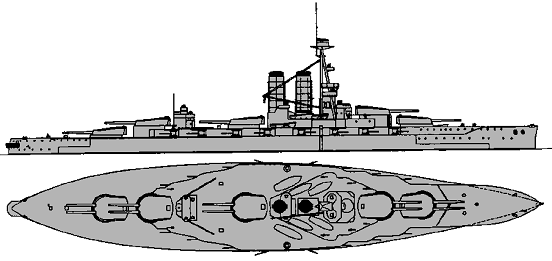
NAVYPEDIA
 Support the project with paypal
Support the project with paypal
Ships
| Name | No | Yard No | Builder | Laid down | Launched | Comp | Fate |
|---|---|---|---|---|---|---|---|
| Reşadiye | Vickers, Barrow, UK | 1.8.1911 | 3.9.1913 | 8/1914 // --- | completed for United Kingdom (Erin) | ||
| Mahmud Reşad V | Armstrong, Elswick, UK | 6.12.1911 | --- | --- | cancelled 1912 | ||
| Fatıh Sultan Mehmed | Vickers, Barrow, UK | 11.6.1914 | --- | --- | cancelled by UK 7.1914 |
Technical data
| Displacement normal, t | Reşadiye, Mahmud Reşad V: 23000 Fatıh Sultan Mehmed: 24700 |
|---|---|
| Displacement full, t | Reşadiye, Mahmud Reşad V: 25250 |
| Length, m | Reşadiye, Mahmud Reşad V: 170.5 Fatıh Sultan Mehmed: 172.2 |
| Breadth, m | Reşadiye, Mahmud Reşad V: 27.9 Fatıh Sultan Mehmed: 27.4 |
| Draught, m | 8.70 mean |
| No of shafts | 4 |
| Machinery | 4 Parsons steam turbines, 15 Babcock & Wilcox boilers |
| Power, h. p. | Reşadiye, Mahmud Reşad V: 26500 Fatıh Sultan Mehmed: 27500 |
| Max speed, kts | 21 |
| Fuel, t | 2120 coal + 710 oil |
| Endurance, nm(kts) | 5300(10) |
| Armour, mm | belt: 305 - 102, bulkheads: 203 - 102, turrets: 279 (faces), barbettes: 254 - 76, deck: 76 - 39, CT: 305 |
| Armament | 5 x 2 - 343/45 Vickers A, 16 x 1 - 152/50 Vickers O, 2 x 1 - 76/50 Vickers N, 4 - 533 TT (beam) |
| Complement | 1070 |
Standard scale images

Erin 1915
Project history
First two ships were ordered in June 1911 by the Turkish Navy. Following the outbreak of the First Balkan War Armstrong demanded better guarantees of payment and work was suspended, not being resumed afterwards. The order was cancelled, when work on Vickers ship was continued at increased pace from May 1913 onwards. Reşadiye was requisitioned for the Royal Navy as HMS Erin in August 1914, when almost complete, Fatıh was ordered from Vickers on 29 April 1914 as a response to the Greek order for a second dreadnought. She was to have been delivered by 29 April 1917 and would be slightly enlarged Reşadiye and generally similar in respect of layout, armament and protection. She was dismantled on the slipway after the outbreak of war in August 1914.
Protection
Main armoured belt was extended between barbettes 'A' and 'Y' and 99.6m long. Between its lower edge (1.12m below wl at normal load) and middle deck its thickness was 305mm and between middle and main decks it was reduced to 229mm. At fore end forward from centre of barbette 'A' thickness of main belt was 152mm at 9.2m part and 102mm at later 4.6m, additional 26.7m of main belt aft from centre of barbette 'Y' also had 152mm and 102mm thickness. Upper belt was extended between barbettes 'A' and 'Y' and main and upper decks and had 203mm thickness, it was closed by 203mm bulkheads, depth of both belts was 6.9m. Main belt was closed abreast end barbettes by fore and aft bulkheads, their thickness was 203mm between upper and main decks and 127mm between main and lower decks. Ends of 102mm belts were closed by 102mm bulkheads.
343mm turrets had 279mm faces and sides, 203mm rears, 76mm floors and 102mm(rear part)-76mm(fore part) roofs. Barbette of 'A' turret had 254mm protection above and 127mm below main deck at fore part and sides and 229mm(above forecastle deck)-127mm(between forecastle and upper decks)-76mm(below upper deck) aft part. Barbette of 'B' turret had 229mm(fore)-254mm(sides and aft) armour over forecastle deck, 127mm between forecastle and upper decks and 76mm below upper deck. Barbette of 'Q' turret had 254mm armour above forecastle deck, 127mm between forecastle and upper decks and 76mm below upper deck. Barbette 'X' had 254mm(fore) protection above forecastle deck, 254mm(sides)-229mm(aft)-127mm(fore) between forecastle and upper decks and 76mm below upper deck. Barbette 'Y' was protected by 229mm(fore) armour above upper deck, 254mm(aft and sides)-127mm(fore) between upper and main decks and 127mm(aft and sides)-76mm(fore) below main deck. CT had 305mm sides and 102mm roof and deck, communication pipe had 152mm protection.
Upper deck had 38mm protection under 152mm battery, main deck between end barbettes had 38mm armour. Middle deck had 25mm thickness at flat and slopes between end barbettes and was connected by slopes with lower edge of main belt. Funnels uptakes had 25mm armour. There was 38mm longitudinal torpedo bulkhead between end barbettes.
 HOME
HOME FIGHTING SHIPS OF THE WORLD
FIGHTING SHIPS OF THE WORLD OTTOMAN EMPIRE / TURKEY
OTTOMAN EMPIRE / TURKEY CAPITAL SHIPS
CAPITAL SHIPS REŞADİYE battleships
REŞADİYE battleships
